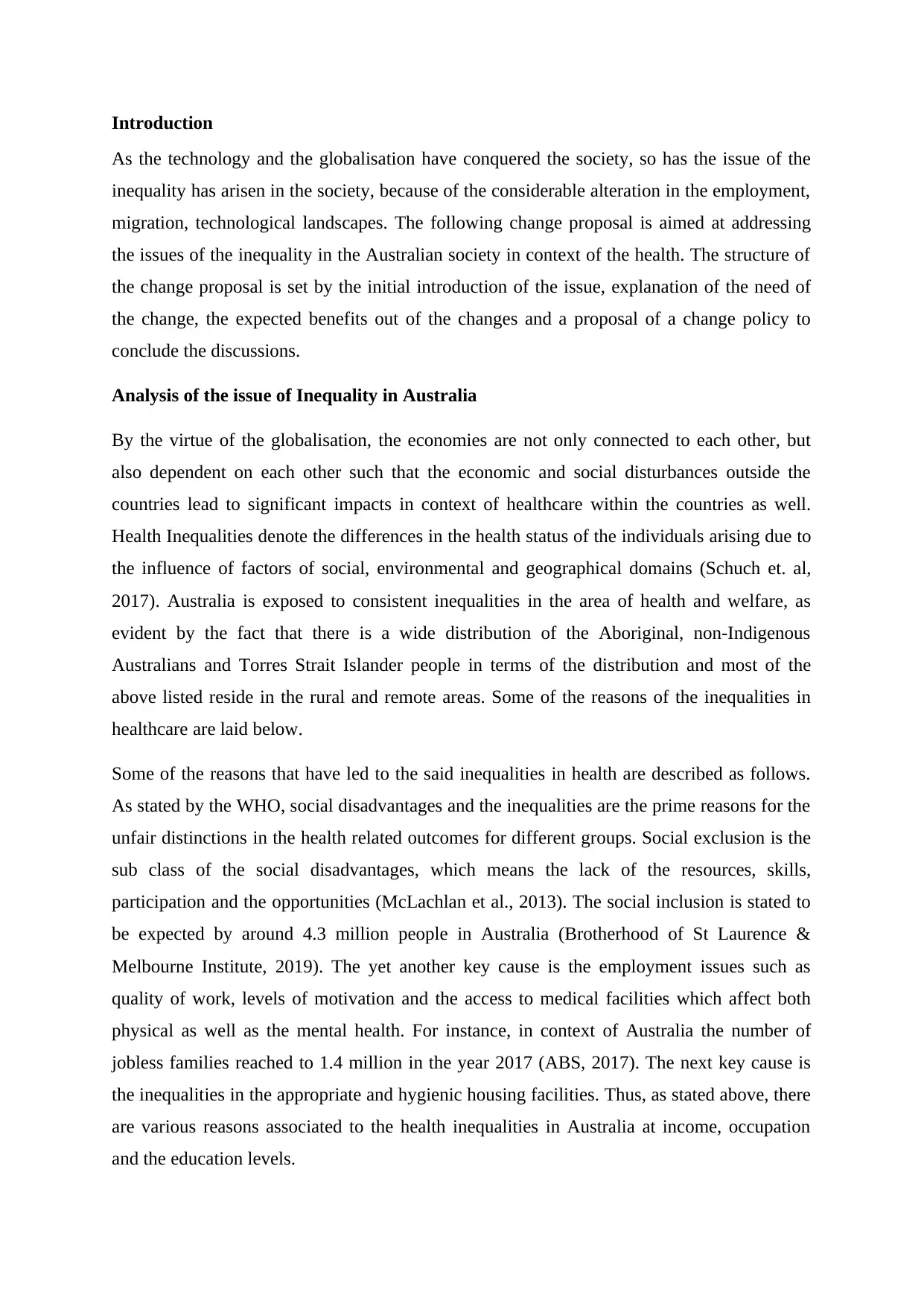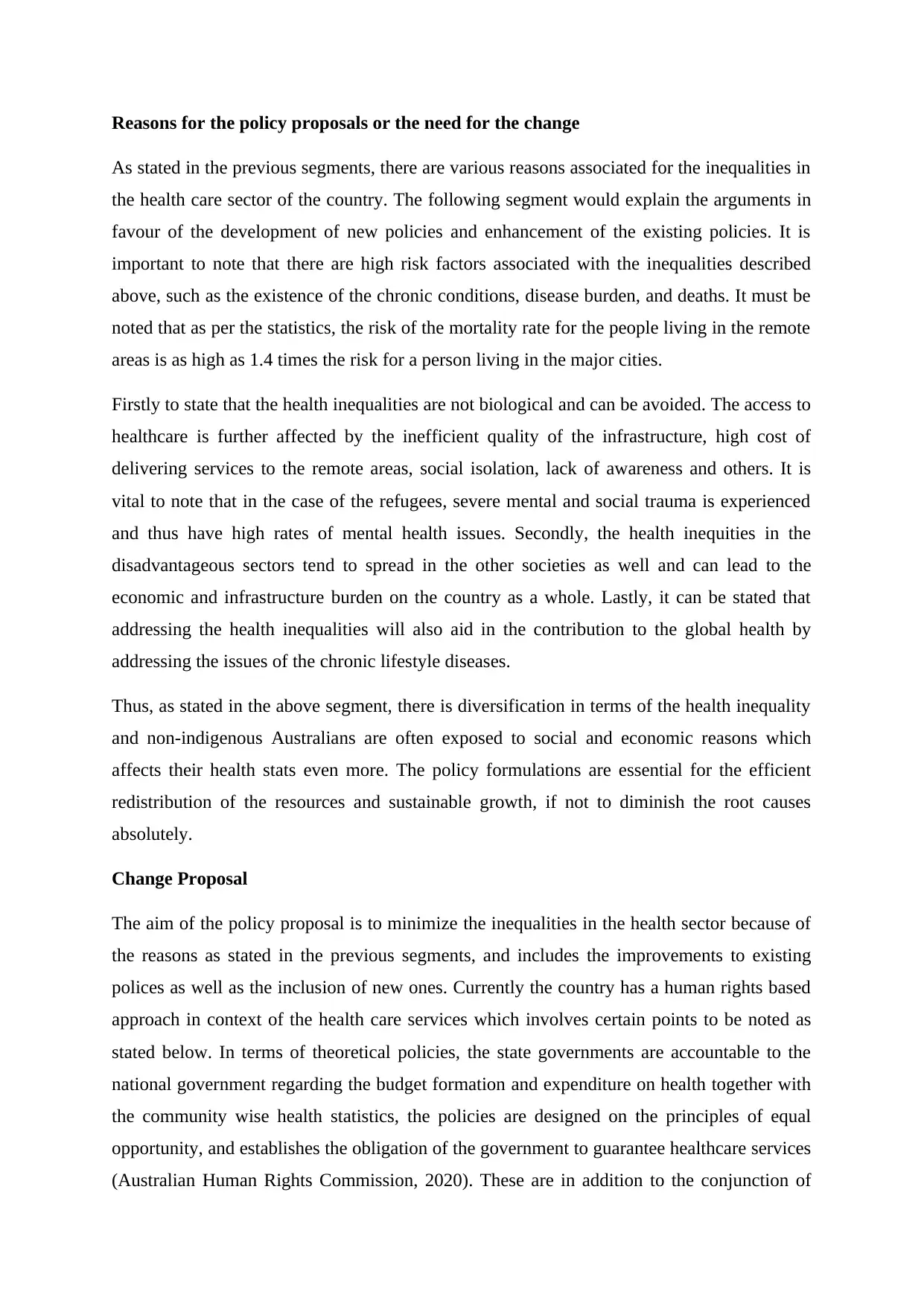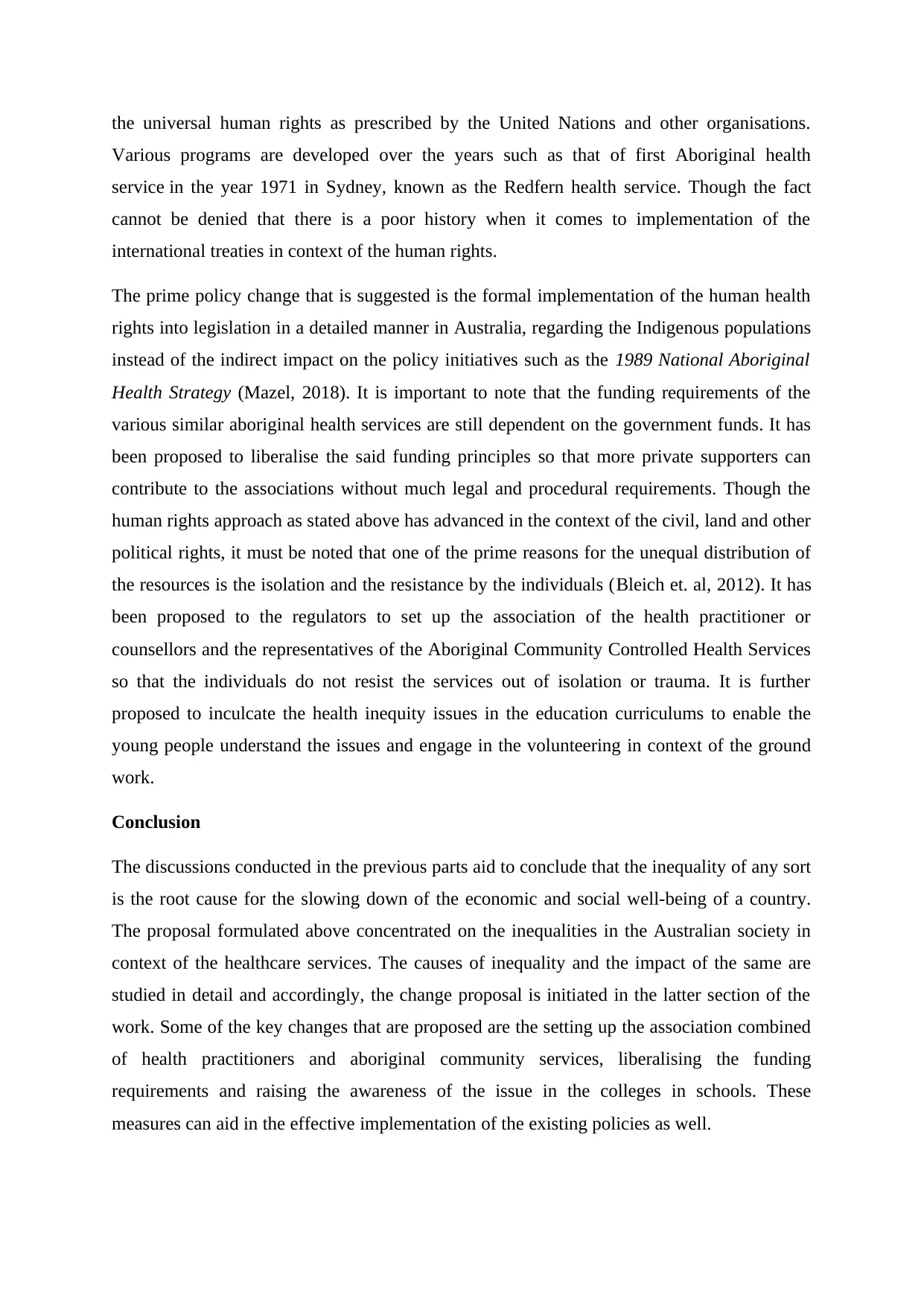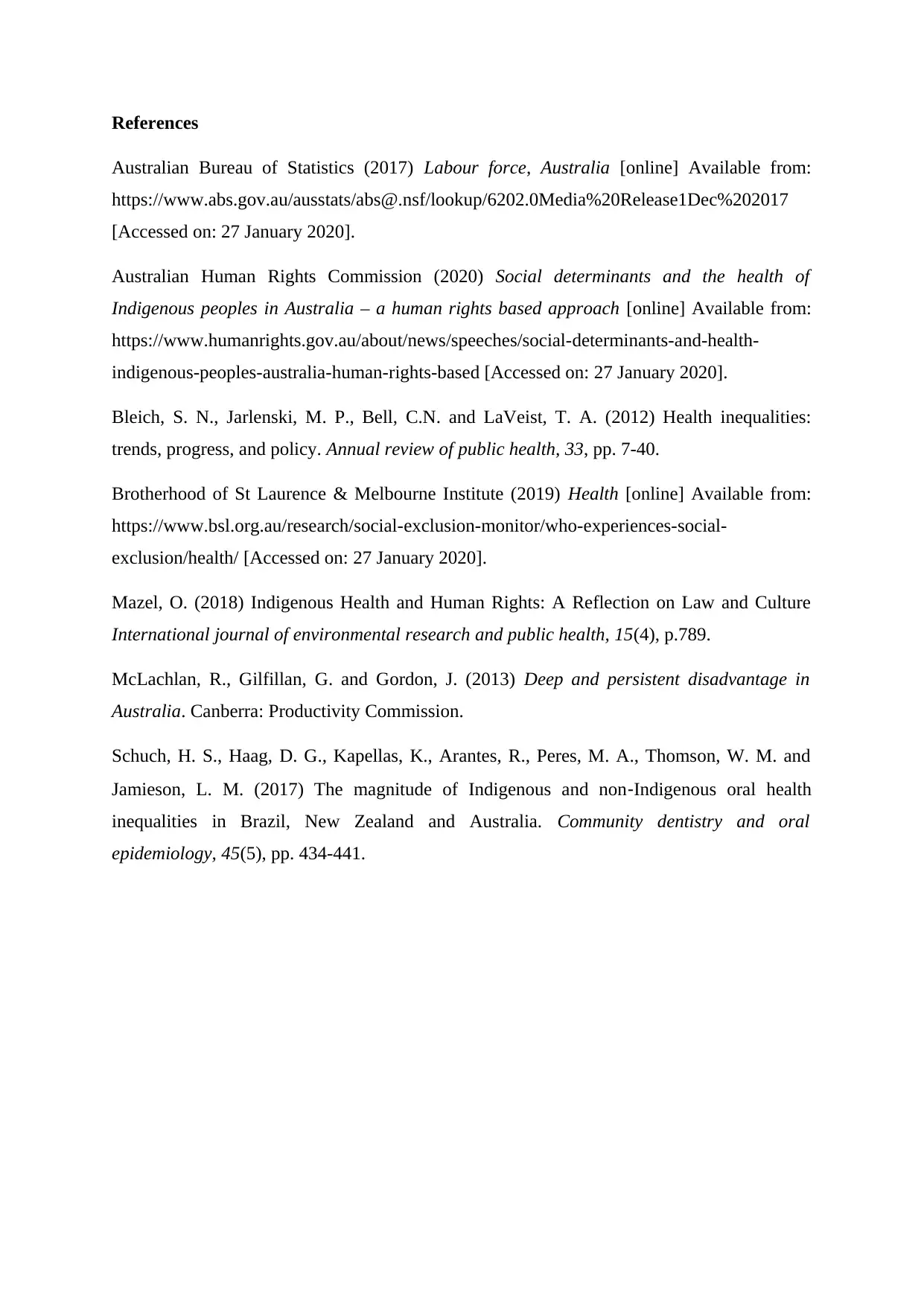Sociology: Health Inequality Policy Change Proposal for Australia
VerifiedAdded on 2022/08/20
|5
|1681
|10
Report
AI Summary
This sociology assignment analyzes the issue of health inequality in Australia, focusing on disparities arising from factors like globalization, employment, and housing. The report identifies key causes such as social exclusion, employment issues, and inadequate housing, which disproportionately affect Aboriginal and Torres Strait Islander populations, as well as those in rural and remote areas. The assignment proposes a policy change to address these inequalities, including the formal implementation of human health rights into legislation, particularly for Indigenous populations. It suggests liberalizing funding for Aboriginal health services to encourage private support and establishing associations between health practitioners, counselors, and Aboriginal Community Controlled Health Services to combat social isolation. Furthermore, the proposal advocates for integrating health inequity education into school curricula to raise awareness and encourage community involvement. The report concludes that addressing health inequality is crucial for Australia's social and economic well-being, and these proposed changes aim to improve healthcare access and outcomes for all citizens. This assignment is available on Desklib, a platform providing AI-based study tools and resources for students.

SOCIOLOGY
CHANGE PROPOSAL
CHANGE PROPOSAL
Paraphrase This Document
Need a fresh take? Get an instant paraphrase of this document with our AI Paraphraser

Introduction
As the technology and the globalisation have conquered the society, so has the issue of the
inequality has arisen in the society, because of the considerable alteration in the employment,
migration, technological landscapes. The following change proposal is aimed at addressing
the issues of the inequality in the Australian society in context of the health. The structure of
the change proposal is set by the initial introduction of the issue, explanation of the need of
the change, the expected benefits out of the changes and a proposal of a change policy to
conclude the discussions.
Analysis of the issue of Inequality in Australia
By the virtue of the globalisation, the economies are not only connected to each other, but
also dependent on each other such that the economic and social disturbances outside the
countries lead to significant impacts in context of healthcare within the countries as well.
Health Inequalities denote the differences in the health status of the individuals arising due to
the influence of factors of social, environmental and geographical domains (Schuch et. al,
2017). Australia is exposed to consistent inequalities in the area of health and welfare, as
evident by the fact that there is a wide distribution of the Aboriginal, non-Indigenous
Australians and Torres Strait Islander people in terms of the distribution and most of the
above listed reside in the rural and remote areas. Some of the reasons of the inequalities in
healthcare are laid below.
Some of the reasons that have led to the said inequalities in health are described as follows.
As stated by the WHO, social disadvantages and the inequalities are the prime reasons for the
unfair distinctions in the health related outcomes for different groups. Social exclusion is the
sub class of the social disadvantages, which means the lack of the resources, skills,
participation and the opportunities (McLachlan et al., 2013). The social inclusion is stated to
be expected by around 4.3 million people in Australia (Brotherhood of St Laurence &
Melbourne Institute, 2019). The yet another key cause is the employment issues such as
quality of work, levels of motivation and the access to medical facilities which affect both
physical as well as the mental health. For instance, in context of Australia the number of
jobless families reached to 1.4 million in the year 2017 (ABS, 2017). The next key cause is
the inequalities in the appropriate and hygienic housing facilities. Thus, as stated above, there
are various reasons associated to the health inequalities in Australia at income, occupation
and the education levels.
As the technology and the globalisation have conquered the society, so has the issue of the
inequality has arisen in the society, because of the considerable alteration in the employment,
migration, technological landscapes. The following change proposal is aimed at addressing
the issues of the inequality in the Australian society in context of the health. The structure of
the change proposal is set by the initial introduction of the issue, explanation of the need of
the change, the expected benefits out of the changes and a proposal of a change policy to
conclude the discussions.
Analysis of the issue of Inequality in Australia
By the virtue of the globalisation, the economies are not only connected to each other, but
also dependent on each other such that the economic and social disturbances outside the
countries lead to significant impacts in context of healthcare within the countries as well.
Health Inequalities denote the differences in the health status of the individuals arising due to
the influence of factors of social, environmental and geographical domains (Schuch et. al,
2017). Australia is exposed to consistent inequalities in the area of health and welfare, as
evident by the fact that there is a wide distribution of the Aboriginal, non-Indigenous
Australians and Torres Strait Islander people in terms of the distribution and most of the
above listed reside in the rural and remote areas. Some of the reasons of the inequalities in
healthcare are laid below.
Some of the reasons that have led to the said inequalities in health are described as follows.
As stated by the WHO, social disadvantages and the inequalities are the prime reasons for the
unfair distinctions in the health related outcomes for different groups. Social exclusion is the
sub class of the social disadvantages, which means the lack of the resources, skills,
participation and the opportunities (McLachlan et al., 2013). The social inclusion is stated to
be expected by around 4.3 million people in Australia (Brotherhood of St Laurence &
Melbourne Institute, 2019). The yet another key cause is the employment issues such as
quality of work, levels of motivation and the access to medical facilities which affect both
physical as well as the mental health. For instance, in context of Australia the number of
jobless families reached to 1.4 million in the year 2017 (ABS, 2017). The next key cause is
the inequalities in the appropriate and hygienic housing facilities. Thus, as stated above, there
are various reasons associated to the health inequalities in Australia at income, occupation
and the education levels.

Reasons for the policy proposals or the need for the change
As stated in the previous segments, there are various reasons associated for the inequalities in
the health care sector of the country. The following segment would explain the arguments in
favour of the development of new policies and enhancement of the existing policies. It is
important to note that there are high risk factors associated with the inequalities described
above, such as the existence of the chronic conditions, disease burden, and deaths. It must be
noted that as per the statistics, the risk of the mortality rate for the people living in the remote
areas is as high as 1.4 times the risk for a person living in the major cities.
Firstly to state that the health inequalities are not biological and can be avoided. The access to
healthcare is further affected by the inefficient quality of the infrastructure, high cost of
delivering services to the remote areas, social isolation, lack of awareness and others. It is
vital to note that in the case of the refugees, severe mental and social trauma is experienced
and thus have high rates of mental health issues. Secondly, the health inequities in the
disadvantageous sectors tend to spread in the other societies as well and can lead to the
economic and infrastructure burden on the country as a whole. Lastly, it can be stated that
addressing the health inequalities will also aid in the contribution to the global health by
addressing the issues of the chronic lifestyle diseases.
Thus, as stated in the above segment, there is diversification in terms of the health inequality
and non-indigenous Australians are often exposed to social and economic reasons which
affects their health stats even more. The policy formulations are essential for the efficient
redistribution of the resources and sustainable growth, if not to diminish the root causes
absolutely.
Change Proposal
The aim of the policy proposal is to minimize the inequalities in the health sector because of
the reasons as stated in the previous segments, and includes the improvements to existing
polices as well as the inclusion of new ones. Currently the country has a human rights based
approach in context of the health care services which involves certain points to be noted as
stated below. In terms of theoretical policies, the state governments are accountable to the
national government regarding the budget formation and expenditure on health together with
the community wise health statistics, the policies are designed on the principles of equal
opportunity, and establishes the obligation of the government to guarantee healthcare services
(Australian Human Rights Commission, 2020). These are in addition to the conjunction of
As stated in the previous segments, there are various reasons associated for the inequalities in
the health care sector of the country. The following segment would explain the arguments in
favour of the development of new policies and enhancement of the existing policies. It is
important to note that there are high risk factors associated with the inequalities described
above, such as the existence of the chronic conditions, disease burden, and deaths. It must be
noted that as per the statistics, the risk of the mortality rate for the people living in the remote
areas is as high as 1.4 times the risk for a person living in the major cities.
Firstly to state that the health inequalities are not biological and can be avoided. The access to
healthcare is further affected by the inefficient quality of the infrastructure, high cost of
delivering services to the remote areas, social isolation, lack of awareness and others. It is
vital to note that in the case of the refugees, severe mental and social trauma is experienced
and thus have high rates of mental health issues. Secondly, the health inequities in the
disadvantageous sectors tend to spread in the other societies as well and can lead to the
economic and infrastructure burden on the country as a whole. Lastly, it can be stated that
addressing the health inequalities will also aid in the contribution to the global health by
addressing the issues of the chronic lifestyle diseases.
Thus, as stated in the above segment, there is diversification in terms of the health inequality
and non-indigenous Australians are often exposed to social and economic reasons which
affects their health stats even more. The policy formulations are essential for the efficient
redistribution of the resources and sustainable growth, if not to diminish the root causes
absolutely.
Change Proposal
The aim of the policy proposal is to minimize the inequalities in the health sector because of
the reasons as stated in the previous segments, and includes the improvements to existing
polices as well as the inclusion of new ones. Currently the country has a human rights based
approach in context of the health care services which involves certain points to be noted as
stated below. In terms of theoretical policies, the state governments are accountable to the
national government regarding the budget formation and expenditure on health together with
the community wise health statistics, the policies are designed on the principles of equal
opportunity, and establishes the obligation of the government to guarantee healthcare services
(Australian Human Rights Commission, 2020). These are in addition to the conjunction of
⊘ This is a preview!⊘
Do you want full access?
Subscribe today to unlock all pages.

Trusted by 1+ million students worldwide

the universal human rights as prescribed by the United Nations and other organisations.
Various programs are developed over the years such as that of first Aboriginal health
service in the year 1971 in Sydney, known as the Redfern health service. Though the fact
cannot be denied that there is a poor history when it comes to implementation of the
international treaties in context of the human rights.
The prime policy change that is suggested is the formal implementation of the human health
rights into legislation in a detailed manner in Australia, regarding the Indigenous populations
instead of the indirect impact on the policy initiatives such as the 1989 National Aboriginal
Health Strategy (Mazel, 2018). It is important to note that the funding requirements of the
various similar aboriginal health services are still dependent on the government funds. It has
been proposed to liberalise the said funding principles so that more private supporters can
contribute to the associations without much legal and procedural requirements. Though the
human rights approach as stated above has advanced in the context of the civil, land and other
political rights, it must be noted that one of the prime reasons for the unequal distribution of
the resources is the isolation and the resistance by the individuals (Bleich et. al, 2012). It has
been proposed to the regulators to set up the association of the health practitioner or
counsellors and the representatives of the Aboriginal Community Controlled Health Services
so that the individuals do not resist the services out of isolation or trauma. It is further
proposed to inculcate the health inequity issues in the education curriculums to enable the
young people understand the issues and engage in the volunteering in context of the ground
work.
Conclusion
The discussions conducted in the previous parts aid to conclude that the inequality of any sort
is the root cause for the slowing down of the economic and social well-being of a country.
The proposal formulated above concentrated on the inequalities in the Australian society in
context of the healthcare services. The causes of inequality and the impact of the same are
studied in detail and accordingly, the change proposal is initiated in the latter section of the
work. Some of the key changes that are proposed are the setting up the association combined
of health practitioners and aboriginal community services, liberalising the funding
requirements and raising the awareness of the issue in the colleges in schools. These
measures can aid in the effective implementation of the existing policies as well.
Various programs are developed over the years such as that of first Aboriginal health
service in the year 1971 in Sydney, known as the Redfern health service. Though the fact
cannot be denied that there is a poor history when it comes to implementation of the
international treaties in context of the human rights.
The prime policy change that is suggested is the formal implementation of the human health
rights into legislation in a detailed manner in Australia, regarding the Indigenous populations
instead of the indirect impact on the policy initiatives such as the 1989 National Aboriginal
Health Strategy (Mazel, 2018). It is important to note that the funding requirements of the
various similar aboriginal health services are still dependent on the government funds. It has
been proposed to liberalise the said funding principles so that more private supporters can
contribute to the associations without much legal and procedural requirements. Though the
human rights approach as stated above has advanced in the context of the civil, land and other
political rights, it must be noted that one of the prime reasons for the unequal distribution of
the resources is the isolation and the resistance by the individuals (Bleich et. al, 2012). It has
been proposed to the regulators to set up the association of the health practitioner or
counsellors and the representatives of the Aboriginal Community Controlled Health Services
so that the individuals do not resist the services out of isolation or trauma. It is further
proposed to inculcate the health inequity issues in the education curriculums to enable the
young people understand the issues and engage in the volunteering in context of the ground
work.
Conclusion
The discussions conducted in the previous parts aid to conclude that the inequality of any sort
is the root cause for the slowing down of the economic and social well-being of a country.
The proposal formulated above concentrated on the inequalities in the Australian society in
context of the healthcare services. The causes of inequality and the impact of the same are
studied in detail and accordingly, the change proposal is initiated in the latter section of the
work. Some of the key changes that are proposed are the setting up the association combined
of health practitioners and aboriginal community services, liberalising the funding
requirements and raising the awareness of the issue in the colleges in schools. These
measures can aid in the effective implementation of the existing policies as well.
Paraphrase This Document
Need a fresh take? Get an instant paraphrase of this document with our AI Paraphraser

References
Australian Bureau of Statistics (2017) Labour force, Australia [online] Available from:
https://www.abs.gov.au/ausstats/abs@.nsf/lookup/6202.0Media%20Release1Dec%202017
[Accessed on: 27 January 2020].
Australian Human Rights Commission (2020) Social determinants and the health of
Indigenous peoples in Australia – a human rights based approach [online] Available from:
https://www.humanrights.gov.au/about/news/speeches/social-determinants-and-health-
indigenous-peoples-australia-human-rights-based [Accessed on: 27 January 2020].
Bleich, S. N., Jarlenski, M. P., Bell, C.N. and LaVeist, T. A. (2012) Health inequalities:
trends, progress, and policy. Annual review of public health, 33, pp. 7-40.
Brotherhood of St Laurence & Melbourne Institute (2019) Health [online] Available from:
https://www.bsl.org.au/research/social-exclusion-monitor/who-experiences-social-
exclusion/health/ [Accessed on: 27 January 2020].
Mazel, O. (2018) Indigenous Health and Human Rights: A Reflection on Law and Culture
International journal of environmental research and public health, 15(4), p.789.
McLachlan, R., Gilfillan, G. and Gordon, J. (2013) Deep and persistent disadvantage in
Australia. Canberra: Productivity Commission.
Schuch, H. S., Haag, D. G., Kapellas, K., Arantes, R., Peres, M. A., Thomson, W. M. and
Jamieson, L. M. (2017) The magnitude of Indigenous and non‐Indigenous oral health
inequalities in Brazil, New Zealand and Australia. Community dentistry and oral
epidemiology, 45(5), pp. 434-441.
Australian Bureau of Statistics (2017) Labour force, Australia [online] Available from:
https://www.abs.gov.au/ausstats/abs@.nsf/lookup/6202.0Media%20Release1Dec%202017
[Accessed on: 27 January 2020].
Australian Human Rights Commission (2020) Social determinants and the health of
Indigenous peoples in Australia – a human rights based approach [online] Available from:
https://www.humanrights.gov.au/about/news/speeches/social-determinants-and-health-
indigenous-peoples-australia-human-rights-based [Accessed on: 27 January 2020].
Bleich, S. N., Jarlenski, M. P., Bell, C.N. and LaVeist, T. A. (2012) Health inequalities:
trends, progress, and policy. Annual review of public health, 33, pp. 7-40.
Brotherhood of St Laurence & Melbourne Institute (2019) Health [online] Available from:
https://www.bsl.org.au/research/social-exclusion-monitor/who-experiences-social-
exclusion/health/ [Accessed on: 27 January 2020].
Mazel, O. (2018) Indigenous Health and Human Rights: A Reflection on Law and Culture
International journal of environmental research and public health, 15(4), p.789.
McLachlan, R., Gilfillan, G. and Gordon, J. (2013) Deep and persistent disadvantage in
Australia. Canberra: Productivity Commission.
Schuch, H. S., Haag, D. G., Kapellas, K., Arantes, R., Peres, M. A., Thomson, W. M. and
Jamieson, L. M. (2017) The magnitude of Indigenous and non‐Indigenous oral health
inequalities in Brazil, New Zealand and Australia. Community dentistry and oral
epidemiology, 45(5), pp. 434-441.
1 out of 5
Related Documents
Your All-in-One AI-Powered Toolkit for Academic Success.
+13062052269
info@desklib.com
Available 24*7 on WhatsApp / Email
![[object Object]](/_next/static/media/star-bottom.7253800d.svg)
Unlock your academic potential
Copyright © 2020–2025 A2Z Services. All Rights Reserved. Developed and managed by ZUCOL.




